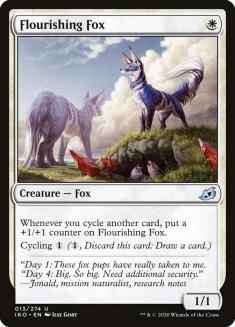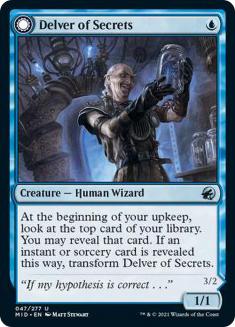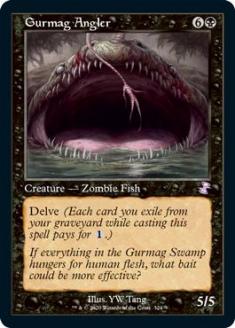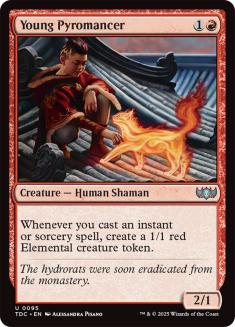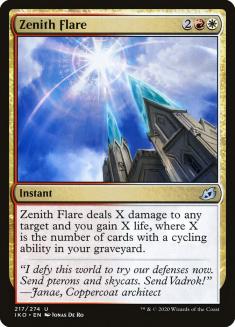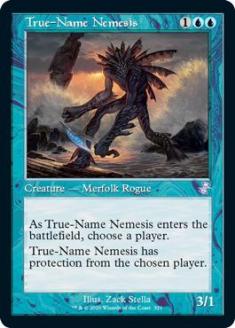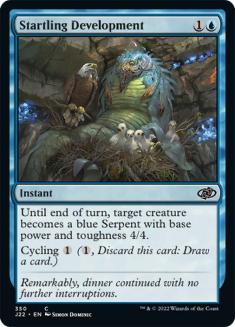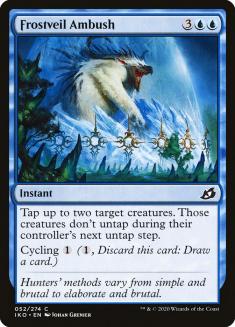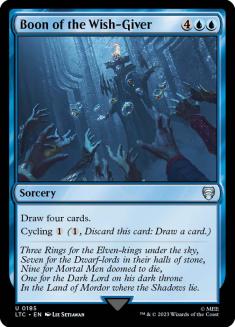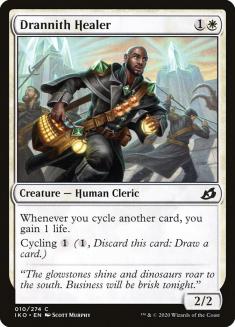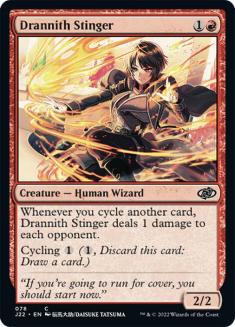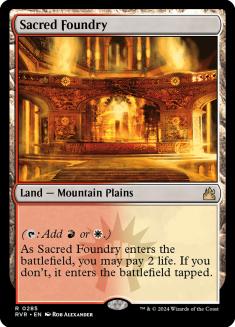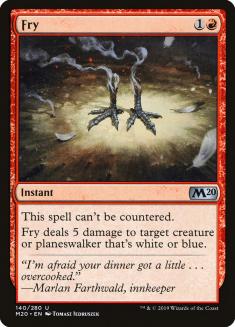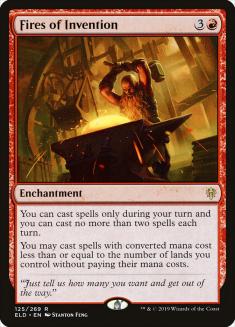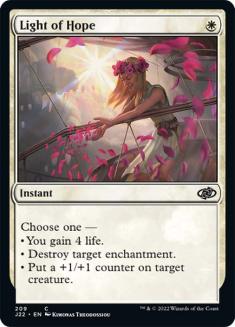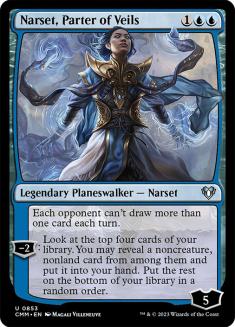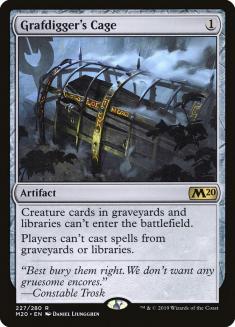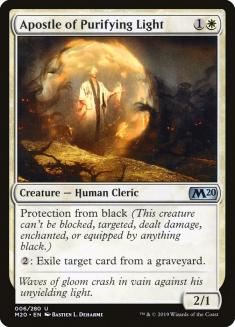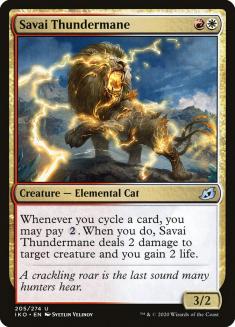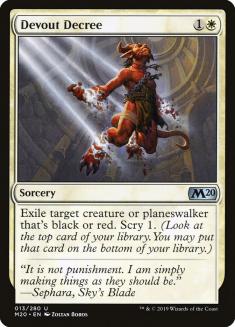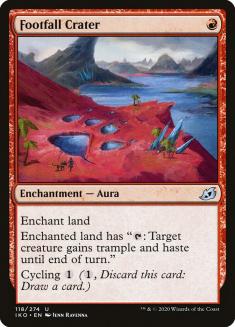Drawing a card is the best part of Magic. Just ask Cedric:
In older formats, archetypes are defined by the number of ways they have to draw a card. Cards that immediately replace themselves, commonly referred to as cantrips, are an integral part of Magic. Modern Izzet Phoenix? Pile of cantrips. Anything blue in in Legacy? Gonna have infinite Ponders and Brainstorms. It’s just the way of things.
At this point, Wizards of the Coast (WotC) has more or less figured out the power of cards like Preordain and has chosen to continuously give us Opt — not too powerful, but still selective enough to be worth it. This means that it’s harder for the decks that rely on infinite cantrips to actually exist in Standard because, well, there just isn’t a high enough density of cantrips in order to make them happen.
Until cycling gets involved.
Creatures (16)
Lands (18)
Spells (26)

On paper, this deck looks like it has very little in common with anything Delver of Secrets, but in practice, the play patterns have a good bit in common.
Flourishing Fox is the Delver of Secrets // Gurmag Angler fuse card that leads to the most busted draws from the deck. If it simply stopped growing once it hit the size of a Wild Nacatl, it would be reasonable, but having a couple of early Foxes is going to make combat a nightmare for the opponent. Outsizing Uro, Titan of Nature’s Wrath on-curve is incredible for any deck looking to apply early pressure.
The fact that Flourishing Fox happens to dodge a good bit of removal makes it even better. On the play, it can’t be hit with the Stomp portion of Bonecrusher Giant, and it gaining counters means that Heartless Act can’t touch it. It’s a great example of a threat that doesn’t require much in terms of investment and that scales to the mid- and late-game.
If you squint hard enough, Valiant Rescuer does a damn good Young Pyromancer impression. In grindy matchups, having one card that pays its controller for simply spending two mana before casting a pile of cantrips is a fantastic tool to have access to. In this deck, Lurrus of the Dream-Den even has the luxury of rebuying the card —a common play pattern considering that Valiant Rescuer is fairly squishy with only a single point of toughness.
On the other side of the coin, creating infinite chump blockers to bridge to a game-ending, difficult-to-interact-with finisher:
Okay, so this analogy is going to seem a little more hamfisted, but stay with me.
The power of True-Name Nemesis in fair mirrors isn’t the fact that it’s a Latch Seeker. True-Name’s real power lies in the fact that it completely shifts the clock of the game and is nigh-impossible to interact with once it has resolved. This is part of what allows Legacy Delver variants to adopt both aggressive and controling roles.
Zenith Flare does something similar for this deck. It can both play as a defensive card a la Tendrils of Corruption or simply be a kicked Fight with Fire that domes opponents for exorbitant amounts of damage.
Having cards that play offensively and defensively is what gives the Cycling deck the flexibility necessary to be an aggro-control deck. That, and its ability to find these tools:
These cards are your Ponders, Preordains, and Sleight of Hands. On the one hand, they don’t have the same selection of their older counterparts, but the fact that they work with the payoff cards in the archetype generates additional value that outweighs the built-in selection.
When cycling cards fuel other ones, the overall feeling is that drawing more cyclers with your cyclers feels like getting free value. Cycling with a Flourishing Fox and a Drannith Stinger on the battlefield? Sounds like casting an instant-speed Opt that also came with a damage and a +1/+1 counter attached.
The Drannith cycle-twins, Healer and Stinger, are the unsung heroes of the deck, working as both payoff cards and ways for the deck to spin its wheels to fuel the more impactful payoffs.
Having a majority of the payoffs have cycling allows the deck to continue firing on all cyclinders in games where it is payoff-flooded. This is important, as the cards that are fueled by cyclers wouldn’t have the same efficacy that they do now if the deck had more dead ends.
As it stands, everything in the deck is either able to be cycled, a Zenith Flare, or a land. This makes lands and extra copies of Zenith Flare feel like dead ends. They don’t cycle, so that piece of cardboard is done generating resources from cycling.
Which brings me to the other version of the Cycling deck that’s been cropping up: Jeskai.
Creatures (16)
Lands (20)
Spells (24)

The draw? More spin-offs of Young Pyromancer, better sideboard cards.
The drawback? More dead ends, worse mana.
Not to spend too much time on lesser iterations of the deck, but outside of a couple of very specific matchups, Jeskai struggles at many things that Boros is good for. On top of playing a payoff card that doesn’t cycle, in order to make the mana for both Flourishing Fox and Improbably Alliance work, the deck has to play more lands.
A higher land count combined with non-cycling payoffs translates to a higher fail-rate that’s more significant than one would assume. Technically, the difference that five or six cards makes isn’t going to matter once, but when the deck plans to spin the wheel multiple times a turn, and over a dozen times per game, the margins end up mattering.
A higher density of dead ends means that the deck isn’t able to adequately pressure the opponent with Fox and Flare in matchups that it’s firmly the aggressor. This also informs how to approach sideboarding with the deck:
VS Keruga Jeskai Fires
Out:
In:
The amount being brought in from the sideboard is going to vary based on how aggressive the matchup needs the Cycling deck to be. In other words: the more aggressive, the fewer interactive cards.
Fry happens to be okay here because it’s the best answer to Kunoros, Hound of Athreos that happens to also tag Keruga, the Macrosage; Sphinx of Foresight; and Kenrith, the Returned King.
As far as cuts go, most of the time, you’re going to be looking at trimming on uncastable cycling cards.
Jeskai Fires, as a matchup, is one of the places that warrants the light black splash in the manabase in order to hardcast Memory Leak. The spots where having access to a Thoughtseize effect is huge are spots where a single card can completely change the level at which the opponent is operating.
This is mostly a nod towards the enchantments that feel like they give the opponent double the normal mana development that should have. Knocking out these cards is what makes decks actually crumple to a 7/7 Fox, or stall the game long enough to dome the opponent for fifteen with a Zenith Flare.
VS Temur Reclamation
Out:
In:
Light of Hope is there to tag Wilderness Reclamation, yet isn’t being brought in against Jeskai Fires. Why?
Wilderness Reclamation actually needs their namesake card to reasonably kill this deck. Kenrith, the Returned King and Cavalier of Flame can just kill someone staring at a glorified Healing Salve in their hand. Temur Reclamation doesn’t have the same ability. The deck also gets pantsed harder by having its namesake destroyed the turn it’s cast.
Fry will come in against most of the non-creature-based blue decks for one single reason: you have to check Narset, Parter of Veils.
The biggest reason that this deck gets to exist is because Narset, Parter of Veils only sees marginal play. (As an aside, this is a lot of why Improbable Alliance didn’t cut it. The matchups it’s best against have a maindeck hate card.)
There are also times that Fry can team up with a token to take out an Uro, but for the most part, the card is made necessary by the fact that Narset is so strong against so many different draws that this deck has.
VS Lurrus Rakdos Sacrifice
Out:
In:
Dedicated and resilient aggro decks are secretly one of the problems that this archetype has, despite looking like they’d be great on paper. At a glance, it’s hard to imagine a deck with a bunch of maindeck lifegain options and the world’s largest Warleader’s Helix would struggle against a low-to-the-ground creature deck. Unfortunately, there’s an aspect of how the games play out to consider:
When exactly are you planning on cycling?
Spinning your wheels against the aggro deck while they apply pressure and commit to the battlefield is a way to end up in rip-Zenith Flare-or-die-trying scenarios. Rebuilding the deck for post-sideboard games is the best way to fix that, and the matchup swings from “unfavorable” to “near-unlosable.”
Navigation
The hardest part of playing the deck is figuring out when it’s correct to commit to the battlefield and when it’s better to cycle. As a general rule of thumb, when I’m the aggressor in the matchup, I’ll cast Drannith Stinger and cycle Drannith Healer. The inverse is true for matchups that have Boros Cycling on the back foot.
Against decks without sweepers, committing infinite copies of Valiant Rescuer to the battlefield will overpower almost anything that doesn’t have evasion. Small-ball creature decks in particular struggle with Bitterblossom effects. Because of this, it’s better to commit one of the 2/2s as bait for a removal spell before casting Valiant Rescuer. That way, if they do have a removal spell for the 3/1, you can at least get one trigger out of it before it goes away.
Playing with Lurrus is tough, but in grindy matchups, I’m hesitant to cast it before it can immediately cast something else for value. That means Lurrus will most frequently be a Turn 5 play, rebuying one of the two-mana creatures.
Outside of some specific situations, you don’t want to rebuy Footfall Crater for the sake of getting value out of Lurrus. It takes a cycler out of your graveyard, reducing the power of Zenith Flares drawn later.
Most of the gameplay comes down to nuts-and-bolts “Who’s the Beatdown?” gameplay. Developing to stay ahead, spinning wheels when developing would equate to an overextension, or knowing when the only way to win is to cycle into the topdecked Zenith Flare for game.
If you like Limited, this is a great way to apply those skills in Constructed. The deck’s much better than anyone thinks and people haven’t started hating it yet. Go farm cheap wins.



